Benefits of Composite Decking VS Wood Decking
Edmonton Decks – Compare Decking Materials
I recently published an article titled “Most Common Edmonton Deck Building Questions”. In that particular article I covered many of the common questions we are asked regarding the construction and permit requirements in order to build an Edmonton Deck. While I tried to cover most of the common questions, I only “scratched the surface” with respect to the different types of materials that can be used, along with the Pros and Cons associated of each. Given that deck and fascia board material is a very important component of any deck, it prompted me to write a more in-depth article in order to shed some additional light on the subject. Let’s look into the benefits of wood decking, and the benefits of composite decking vs wood.
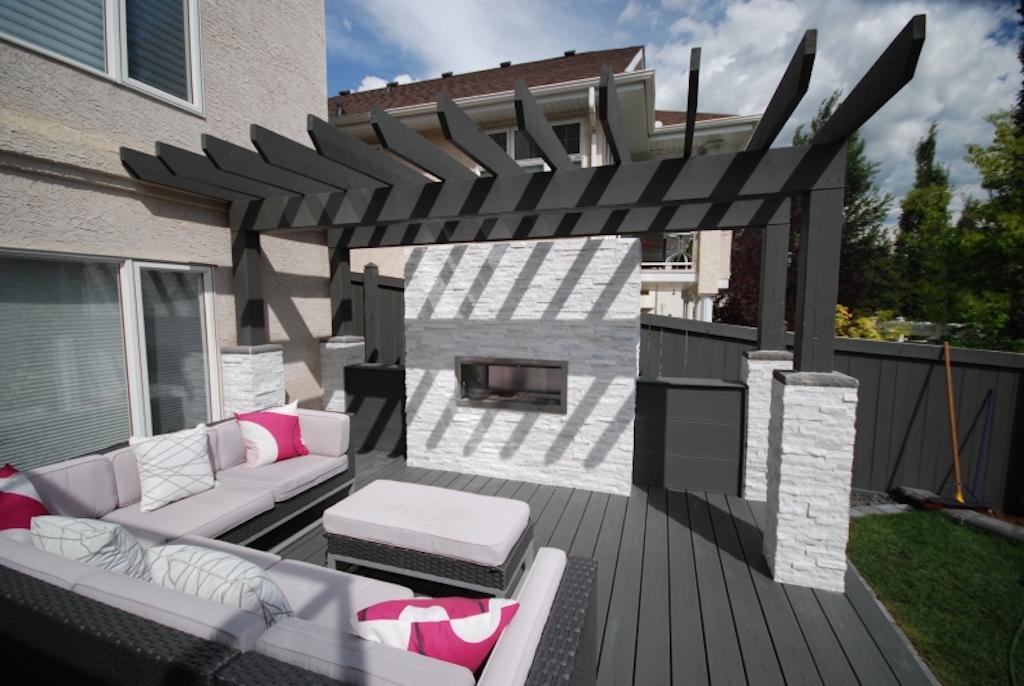
On this deck we incorporated TimberTech Tropical Collection (Amazon Mist) composite deck and fascia boards, with a custom built (Pressure Treated) Pergola, Gas Fireplace and we finished the whole thing off with some really nice Natural (white) Ledgestone. It turned out to be a real cozy and relaxing… OutdoorSpace!
Deck Framing
At OutdoorSpace we construct all of our deck frames using “Preservative-Treated Wood”, which is commonly referred to in Canada as “Pressure Treated Lumber”. It’s referred to as “Pressure Treated” as a result of the process the lumber goes through at the sawmills. Chemicals are driven a short distance into the wood using a special vessel that combines pressure and vacuum. Although deeper penetration is highly desirable, the impermeable nature of dead wood cells makes it extremely difficult to achieve anything more than a thin (outer) shell of treated wood. Key results of the pressure-treating process are the amount of preservative impregnated into the wood, which is (retention) and the depth of penetration. As a result of the inherent flaws associated with the process, the protection layer can typically be quite thin and definitely not a guarantee from future rotting.
Fact is – Deck surfaces can last (but not necessarily look so good) anywhere from 10 to 20 years if constructed from untreated wood such a spruce, but they will only last this long if they are maintained properly. Decks utilizing Cedar boards can outlast Pressure Treated deck boards, but once again they will need to be maintained. Decks incorporating Composite Materials can last as long as 30 (plus) years, and they can do so with very limited maintenance. So as you can see, the choice you make today will definitely become a factor tomorrow!
You should consider your deck as a long-term investment and one that you, your family and friends will enjoy for many years to come. If constructed correctly, it will also increase the value of your property. With these things in mind, it’s really important for you to understand the different materials that are available… BEFORE you hammer a single nail into a piece of wood!
In order to assist you with your decision, let’s take a look at some of the different things you should take into consideration when designing your next… Edmonton Deck Building Project.
Deck and Fascia Boards
Now this is where the options are many. Decks can be finished with a multitude of materials ranging from Pressure Treated Lumber, Cedar or Composite (manmade) Material, of which there are many styles and varying degrees of quality to choose from.
Wooden Decks
Many people gravitate towards “Real Wood” for their decks because it has been the “material of choice” for many, many years. Not to mention the fact that we have plenty of it right here in Canada.
Fact is – There is wood, and then there is wood. The type of lumber you choose for a wooden deck is critically important to the longevity and overall maintenance requirements of your deck as time passes by, and especially in the climate we live in!
Pressure Treated Lumber is available in two (green or brown) colour options, but the color doesn’t really matter because you can stain or paint it any colour you want. The downside of this type of product; it’s susceptible to warping, splitting and cracking, so it requires regular maintenance and will look tired over time regardless of how much effort you put in.
If you want to go the “natural” route, you can always go with a wood that is more weather-resistant such as “Cedar”. These types of decks look beautiful when they are first constructed, but they require a TON of ongoing maintenance! If you are prepared to invest the time, energy and resources that’s great, but if time is something you don’t have much of, then I would highly recommend you steer clear of this type of deck material!
Composite Decks
As a result of the relatively “low maintenance” aspect of Composite Decking materials, coupled with the advancement in technology, Composite Deck materials are becoming increasingly popular and the “go-to” choice of many consumers. The Deck and Fascia Boards comprise primarily of a mixture of “recycled plastic” and “wood fibers”. While decks built with these materials can lack in “natural” appearance and do not possess the natural beauty of a real-wood, you can choose from a vast array of colors and finishes to mimic a more “natural” look. Technology advancements in this type of decking also provides for a much “cleaner” and “modern” look! Plus… there are no splinters to worry about!
The strongest argument for the use of “Composite Decking Materials” is the relative “low-maintenance” requirements. NO sanding, NO refinishing and NO staining… EVER! In addition to these (time and cost saving) benefits, most manufacturers typically offer at least a 20-year warranty, and in some cases… a LIFETIME GUARANTEE! The downside, as you might expect… is COST. Depending on the manufacturer and the product line you elect to go with, you will be looking at an investment that is at least twice the cost of a wood deck.
Note to reader… not all Composite Decking Material should be considered as EQUAL!
Like anything you purchase, the cost is reflective of the quality of the decking material and specifically the construction of the material and the warranty being offered by the manufacturer. There is no question, some products on the market are definitely “inferior” to others, so make sure you do your homework… BEFORE you buy!
One consideration BEFORE you buy… you do get what you pay for!
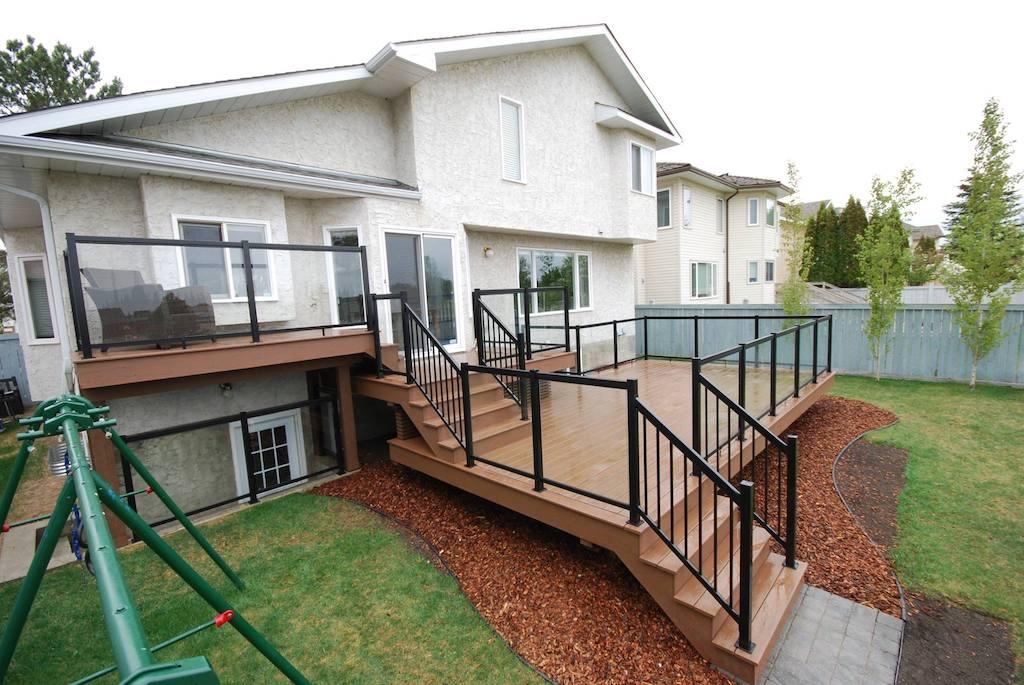
On this multi-level custom built deck we incorporated TimberTech Tropical Collection (Antique Palm) composite deck and fascia boards and we finished it off with the installation of a custom Aluminum and Glass Railing System.
Deck Maintenance
All decks, including Composite require varying degrees of maintenance. Natural wood decks such as “Cedar” are the most demanding, requiring annual refinishing which typically involves sanding and stripping last year’s finish before you can apply a fresh coat of stain. If you love the look of “natural” wood and you don’t mind spending the time, it can definitely be worth it!
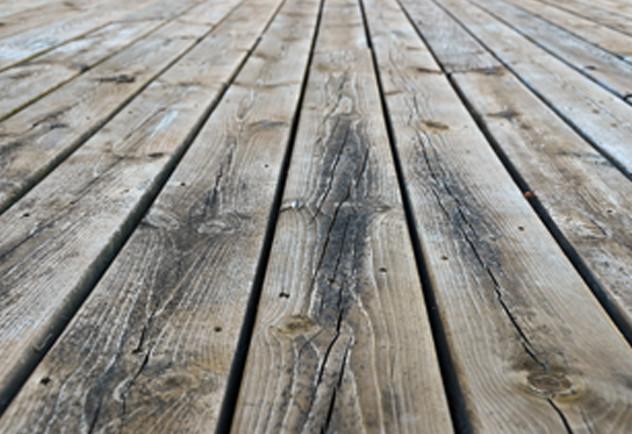
This is a perfect example of what you can expect a “Pressure Treated” deck to look like if it is not maintained on a regular basis. We are sure you will agree… it’s not that attractive and it will definitely pose a serious hazard to those bare feet as a result of all those nasty splinters!
Although traditional lumber is still attractive to many home owners, the appeal often fades as quickly as the wood does. No pun intended, but definitely a reality! Without frequent and ongoing maintenance, Pressure Treated wood decks tend to splinter, warp or cup, and this can happen within the first few years after the initial installation. The other thing that is often overlooked, wooden deck boards need to be screwed down, because unlike Composite deck boards, they do not have grooves in which to install hidden fasteners. As a result, wooden deck boards are unable to compete with the “clean, smooth and modern” look of a Composite deck board. In the long run, wooden decks can become an expensive and time consuming addition to a home.
If you want to prolong the look of your pressure treated deck, it requires refinishing with a clear sealer or stain “every other year”, but the frequency will ultimately depend on how much the deck gets used and what type of activities the deck is subject to.
For decks utilizing “Composite Materials” no refinishing is required, but we do recommend that you pressure washed the deck at least “twice per year”. Once in the spring after the snow and ice has melted and again in the fall after you have put your deck furniture away for the season. By incorporating an effective and ongoing maintenance program, you will prevent the build-up of surface grime or moss, minimize staining and preserve the overall look and appearance of the deck. Not to mention the fact that will protect your investment and reap the rewards when it comes time to sell your property.
As we mentioned before… not all Composite Decking Material should be considered as EQUAL!
With this in mind, and in-line with our company philosophy of utilizing only the best products on all of our OutdoorSpace projects, TimberTech is our “go-to” Composite Decking manufacturer of choice. They offer superior quality, a wide range of price points to choose from, an awesome selection of finishes and colors plus a warranty that is one of the BEST in the industry!
With this in mind, here are a couple of TimberTech products that look similar, but are VERY different from each other.
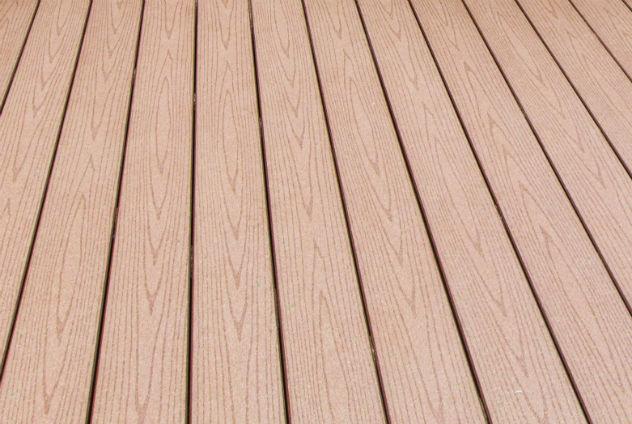
Wood Composite deck boards by TimberTech are offered in their (lower end) “Reliabord, Twinfinish & Docksider Collections”
TimberTech’s “Wood Composite” decking is made of plastic and wood fibers, making it more resistant to the elements than traditional wood. Composite deck boards are “splinter free” and upkeep is relatively low, so there is no need to seal or stain your deck for protection annually, unlike Pressure Treated or Natural Wood Decks. This offers the consumer a balance of affordability and aesthetics, so these practical low-maintenance decks are a great option.
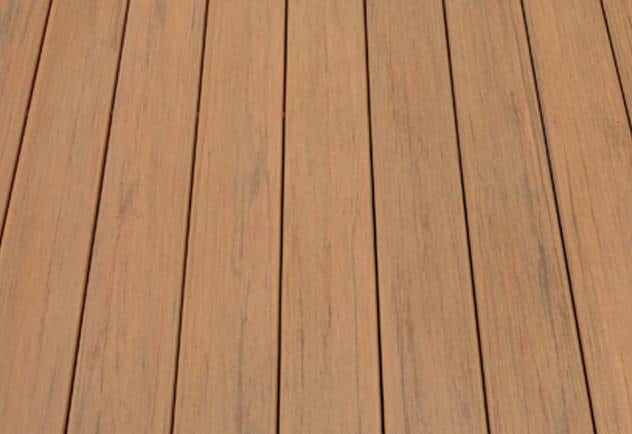
Capped Wood Composite deck boards by TimberTech are offered in their (upper end) “Legacy, Terrain & Tropical Collections”.
With the look and feel of real lumber, TimberTech’s “Capped Composite Decking” offers the charm of traditional wood without the hassle associated with frequent maintenance. TimberTech’s composite core is made of plastic and wood fibers and encased with a protective cap on “all four sides and every groove”. While most manufacturers cut corners and neglect the bottom of the deck board and groove, TimberTech goes the extra mile making the deck boards strong enough to resist scratches, stains and fading. It provides a “high end” look with added strength that will outlast and is the envy of most of its competitors.
How Natural Wood Stacks Up Against Composite Decking Materials – How much is composite decking VS wood?
| CATEGORY COMPARISON | PRESSURE TREATED & SOFT WOODS | TIMBERTECH® CAPPED WOOD COMPOSITE |
|---|---|---|
| Debut Year | N/A | 2008 |
| Maintenance | Annual Staining & Sealing | Periodic Cleaning |
| Aesthetics | Must be Stained or Painted | Real Wood Look |
| Residential warranty | None | 30-year Limited Fade & Stain Warranty30-year Limited Warranty on Material Defects, Termite & Rot Damage |
| Durability | ||
| Mold & mildew resistance | N/A | |
| Stain resistance | ||
| Scratch resistance | ||
| Fade resistance | ||
| Splinter free | N/A | |
| Estimated initial upfront cost | $6.5K | $7.9K |
| Estimated cost of ownership over 20 years** | $23.3K | $8.9K |
* Cost of ownership is an estimate based on the average deck size of 320 square feet and includes all materials and labor for annual cleaning/staining and pressure washing.
In Summary
There are a multitude of deck materials to choose from, some of which are far more economical than others, but if you intend on spending plenty of time on your deck and you truly care about how your OutdoorSpace will look, then you have to factor in maintenance costs over the lifetime of the deck when making your material selection. We trust the chart above put that consideration into perspective for you?
We hope you found this article both informative and educational?
Should you have any questions or if you would like to schedule your FREE Deck Consultation… we would love to hear from you!
Also check out:
– Most Common Edmonton Deck Building Questions
– View our reviews on Google
– View our record with the BBB

